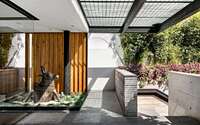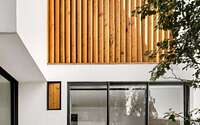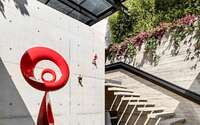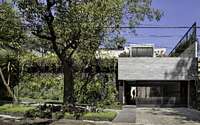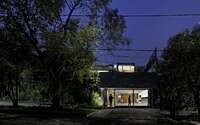Cachai House by Taller Paralelo
Cachai House recently redesigned by Taller Paralelo, is a contemporary two-story residence located in Mexico City, Mexico.











About Cachai House
Cachai House: Breathing New Life into a 1960’s Gem
Tucked in Mexico City’s sought-after urban enclaves, Cachai House rejuvenates an abandoned 1960’s dwelling.
Intricately Designed Layers
The entrance boasts a multi-use space and a serene water body, ensuring complete independence. Above, the ground floor unveils a lush garden, benefiting from the wastewater treatment plant. The first level showcases public and service domains, including a well-lit living space with a terrace. Here, a backyard doubles as a hub for ventilation and light, adorned with a water feature and a Japanese guava tree. The second level houses the dining area, kitchen, and bedrooms. Lastly, recreation defines the third level.
Eco-Conscious Living
Cachai House champions self-sufficiency. Solar energy, a rain-harvesting system, and a sewage treatment plant power its ecological prowess.
Honoring Original Structure
Optimizing the original structural components was crucial. Not only did this approach minimize waste, but it also inspired the half-levels design. This unique layout enhances the home’s microclimate and offers expansive outdoor views.
Thoughtful Orientation and Ventilation
Space positioning leans on the southern orientation. Factoring in solar incidence, cross-ventilation from patios and terraces became essential. As one ascends, solar exposure intensifies, making the terrace and guava tree patio the most temperate spots. Meanwhile, other southern-facing terraces radiate warmth.
Harnessing Water: Collection and Treatment
Rainwater collection meets potable needs during the rainy season, with a month’s reserve. Impressively, the irrigation system solely relies on treated water year-round. With recycled treated water and potable rainwater, the home targets a 75% average demand reduction. Consequently, municipal water consumption drops by 50% annually, and rainwater contributes an extra 20-25%.
The rainwater system can harvest 15,000 lt (3,962.58 gallons) per event, purifying 50 lt (13.21 gallons) a minute. Meanwhile, the wastewater plant processes 1,200 lt (316.88 gallons) daily, meeting irrigation demands.
Solar Energy: A Sustainable Approach
Though the house links to CFE, it primarily draws energy from solar cells. Energy surplus ensures a favorable balance.
Photography courtesy of Taller Paralelo
Visit Taller Paralelo
- by Matt Watts











